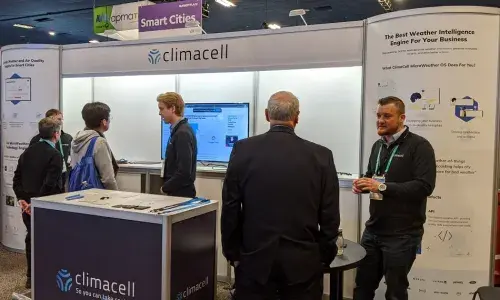
So, how’s that disruption going?
About a year ago, I penned a post to introduce National Grid Partners. In it, I told the cautionary tale of Blockbuster Video: how Netflix effectively put the company out of business just three years after going public.
My point was that disruption can happen in any industry. Including ours.
It’s for that reason we formed National Grid Partners, funded it with $250 million of the company’s money, and launched it as the utility industry’s first Silicon Valley-based investment and innovation firm. And we did it for one reason, and one reason only.
To help ourselves.
Because the energy business is changing – from the way power is generated and how people pay their bills to who actually gets to call themselves an energy company. We have to be actively looking to make sure we’re prepared – and not the next Blockbuster.
Think of this work as creating and managing an investment portfolio. My team scouts for new companies, new technologies, and new ways of thinking. The goal is to buy in early so we can disrupt the industry – but also ourselves.
So as a beneficiary of all this investing, it would be fair of you to ask: how’s my portfolio doing?
We have already sifted through more than 1,000 potential investments and taken stakes in 15. We plan to invest in another 15 companies this fiscal year, potentially spending $100 million. And we just opened an office in San Francisco to help fast-track the success of our early stage portfolio companies.
There are a lot of things I could tell you about every company. But I’d rather provide a few discrete examples to illustrate their potential for disruption – from deep inside our walls to well outside them.
Inside: Analyzing, Optimizing, & Protecting Our Grids
Our work is easy to describe – deliver exactly the energy people need, where they need it, and when they need it. The difficulty lies in everything else: the energy we have available at any given time, the health of our equipment, and the flexibility of our digital tools – to say nothing of the weather.
Those realities put a premium on our ability to analyze, optimize, and protect our energy grids. We’ve made several investments with that idea in mind.
Take AutoGrid. It focuses on the real-time balancing of energy supply and demand. We’re already using it to support the just-in-time delivery of more than 400 megawatts of electricity to commercial and industrial customers in Massachusetts, New York, and Rhode Island. In fact, its technologies are so powerful that they could have the potential to be a core building block for National Grid’s distributed energy management at a national level.
AutoGrid is also one of a group of companies that is redefining the very idea of what an energy producer looks like through a concept called virtual power plants. These plants buy excess energy – from commercial and industrial users as well as people who can spare it from their solar panels, car batteries, or smart home heating systems – and resell it. They never generate a single kilowatt themselves.
As for optimizing the delivery of reliable, safe, and affordable energy, making the right decisions at the right time is paramount. It’s why we invested in Copperleaf, whose software can run complex what-if analyses to help ensure that when we replace or refurbish equipment, we spend our money wisely, minimize grid downtime, and keep our operations as safe as possible.
Finally, there is protecting our grids from digital intrusion.
It’s an unfortunate reality that hackers will probe computing networks, look for unguarded entrances, and seize them for ransom. It’s why we took a stake in Dragos, a global leader in the protection of industrial control systems like ours. This investment is anticipated to leapfrog National Grid to the front of line in terms of industrial cybersecurity. We already have a pilot program underway with Dragos in the UK and expect to expand it to the United States soon.
Outside: Better Weather Prediction, Digital Assistance In More Languages, and Easier Payments
To understand our investments outside the walls of National Grid, take a look at the sky. While it might be sunny outside your window it might be raining only a couple of miles away.
The reality is that weather is an incredibly broad term. When you look at a region of any appreciable size, it’s really a collection of microclimates: small areas with variations in air temperature, wind speed, and precipitation.
Those small differences – even a couple of degrees Centigrade or Fahrenheit – can cause energy demand to rise or fall. It’s for that reason we invested in ClimaCell, which maps and predicts micro-weather in real time all over the world. ClimaCell offers one of the most accurate views of the weather available and provides National Grid with the minute-by-minute forecasts we need to better assist us in meeting spikes in energy demand and foreseeing potential outages.
Finally, there is the issue of how we get paid.
Just as Netflix disrupted Blockbuster, so too are companies changing the way companies bill and receive payment for their services. We see a great opportunity in GoCardless, a firm in which we recently invested. It lets people pay recurring bills via debit charge from whatever bank they use – even if they change banks. For companies like National Grid, this streamlined approach would help to eliminate delays due to declined card numbers, time spent trying to reach customers for new billing information, and the manual data-entry to update their records.
Living With A Head In Two Worlds
I’ll end this post with a quotation that I used at the beginning of my first one. It comes from our CEO, John Pettigrew, and captures the world in which my team lives.
“Innovation, at its core, is about trying to be the master of your own disruption. You live with a head in two worlds: one where you run an existing business efficiently and another where you systematically look for opportunities that don’t yet exist…but that you don’t want to miss.”
Disruption is inevitable, even in our industry. But as the leader of the team that’s investing in disruption – to make sure we’re not overrun by it – I’m happy to report the returns look good so far.
I am the Chief Technology and Innovation Officer of National Grid, a multinational electricity and gas utility company and am the Founder and President of National Grid Partners, the innovation and investment arm for National Grid. I sit on the NVCA Board of Directors, where I am co-chair of the Venture Forward initiative. I was a Managing Partner at the Westly Group, responsible for investments in software, energy, and IOT and a Vice President at Intel Capital and the Managing Director of Intel Capital’s Software and Services Group and the Intel Capital Diversity Fund. I am the founder and CEO of a non-profit called UPWARD, which is a global network for advancing professional women.
To learn about our most recent investments, read our latest press release here or go check out our portfolio companies.


